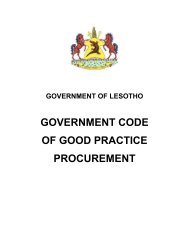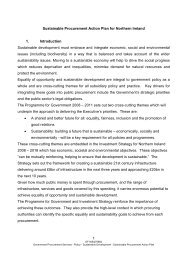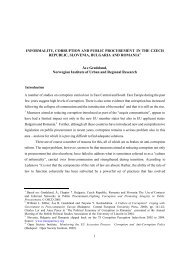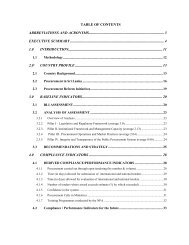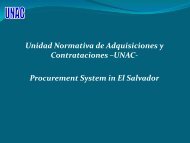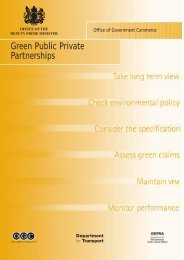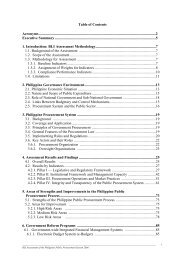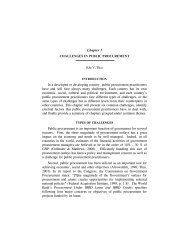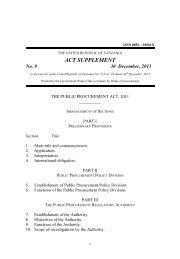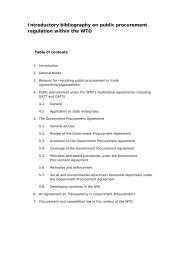Compendium of Country Examples and Lessons Learned from ...
Compendium of Country Examples and Lessons Learned from ...
Compendium of Country Examples and Lessons Learned from ...
You also want an ePaper? Increase the reach of your titles
YUMPU automatically turns print PDFs into web optimized ePapers that Google loves.
<strong>Country</strong> Sampling for CPI Stakeholder involvement/Validation Procurement Capacity Development (CD) Plan based on assessmentresultsYemen 36Latin AmericaParaguayProjects over equivalent <strong>of</strong>approximately 630,000 USDfor the year 2007 <strong>of</strong> 4 keyministries.14 performance indicatorsassessed.The following sample wasused to assess thecompliance indicators:For indicators 1b-1h; 2b, c, f;3b,d; 6c; <strong>and</strong> 8b, aconsulting firm specialized inauditing evaluated a sample<strong>of</strong> procurement transactionsrecorded in the DGCPdatabase between Jan 2004<strong>and</strong> Apr 2006.The selected procurementsrelated to 7 entities (3A non-<strong>of</strong>ficial Arabic version <strong>of</strong> theMethodology was prepared to help thespecialists underst<strong>and</strong> the description <strong>of</strong>some sub-indicators or their criteria.Interviews with 4 ministries wereconducted <strong>and</strong> scores were assigned atthe ministry level. The procurementspecialists <strong>of</strong> the relevant ministriesreceived a copy <strong>of</strong> their assessmentresults.The assessment was conducted jointly bythe national authorities <strong>and</strong> WorldBank/IADB.In a workshop, representatives <strong>of</strong> thegovernment, civil society, business <strong>and</strong>labour associations <strong>and</strong> the private sectorreviewed each comment, finding <strong>and</strong>score initially awarded by the consultants,confirming or correcting them <strong>and</strong> addingrecommendations for correcting problems<strong>and</strong> optimising the system. Theassessment results were validated by theWorld Bank/IDB fiduciary assessmentFurther recommendations are outlined for Pillar 2, 3 <strong>and</strong> 4. They addressissues such as:Integration between public financial management <strong>and</strong> procurement; guidelineson procurement records keeping; establishment <strong>of</strong> national procurementinformation system; development <strong>and</strong> implementation <strong>of</strong> a comprehensiveprocurement capacity building program focusing on procurement procedures,legal <strong>and</strong> administrative requirements, but also on modules dealing withprocurement planning, cost estimation, budgeting, record keeping, <strong>and</strong> withethical <strong>and</strong> performance st<strong>and</strong>ards <strong>and</strong> pr<strong>of</strong>essionalism; procurement audits,etc.No procurement capacity development plan included in the assessment report.The assessment report outlines a recommended action plan which wassupposed to be detailed in a subsequent workshop in terms <strong>of</strong> priorities <strong>and</strong>needed cooperation for implementing it. The following actions are consideredhigh in priority: require all procuring entities to use st<strong>and</strong>ard bidding documents; substantially reduce resort to sole sourcing through better procurementplanning <strong>and</strong> contract management; consider introducing new procurement methods such as frameworkcontracts; incorporate into the SIAF all the autonomous entities currently outside thesystem, the municipalities <strong>and</strong> the provincial governments. Reviselegislation to make the process m<strong>and</strong>atory;36Non-pilot country.78 COMPENDIUM OF COUNTRY EXAMPLES AND LESSONS LEARNED […] - © OECD 2008



